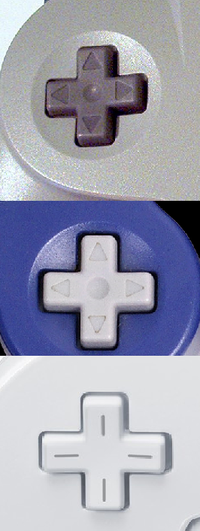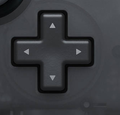| Welcome to SmashWiki! Log in or create an account and join the community, and don't forget to read this first! |
| Notices |
|---|
| The Skill parameter has been removed from Smasher infoboxes, and in its place are the new "Best historical ranking" and "Best tournament result" parameters. SmashWiki needs help adding these new parameters to Smasher infoboxes, refer to the guidelines here for what should be included in these new parameters. |
| When adding results to Smasher pages, include each tournament's entrant number in addition to the player's placement, and use the {{Trn}} template with the matching game specified. Please also fix old results on Smasher pages that do not abide to this standard. Refer to our Smasher article guidelines to see how results tables should be formatted. |
| Check out our project page for ongoing projects that SmashWiki needs help with. |
Directional pad: Difference between revisions
mNo edit summary |
No edit summary |
||
| Line 3: | Line 3: | ||
[[File:DPad.png|thumb|The directional pad of the Nintendo 64 controller, the GameCube controller, and for both the Wii Remote and the Classic Controller.]] | [[File:DPad.png|thumb|The directional pad of the Nintendo 64 controller, the GameCube controller, and for both the Wii Remote and the Classic Controller.]] | ||
The '''directional pad''' (shortened '''d-pad''', officially '''+ Control Pad''') refers to the grey, cross-shaped group of buttons on the left side of the [[GameCube controller|GameCube]] and [[Nintendo 64 controller|Nintendo 64]] [[controller]]s, the varyingly-colored cross-shaped group of buttons located on the [[Wii Remote]], [[Classic Controller]], [[Nintendo 3DS]], [[Wii U GamePad]], and [[Wii U Pro Controller]], and grey, cross-shaped group of buttons on the left side of the [[Nintendo Switch Pro Controller]]. | The '''directional pad''' (shortened '''d-pad''', officially '''+ Control Pad''') refers to the grey, cross-shaped group of buttons on the left side of the [[GameCube controller|GameCube]] and [[Nintendo 64 controller|Nintendo 64]] [[controller]]s, the varyingly-colored cross-shaped group of buttons located on the [[Wii Remote]], [[Classic Controller]], [[Nintendo 3DS]], [[Wii U GamePad]], and [[Wii U Pro Controller]], and grey, cross-shaped group of buttons on the left side of the [[Nintendo Switch Pro Controller]]. The [[Joy-Con]] have a group of four buttons in a diamond shape in the same place called the directional buttons, with the same purpose. | ||
In ''[[Super Smash Bros.]]'', it serves no purpose other than menu navigation. In ''[[Super Smash Bros. Melee]]'', it continues to function as menu navigation, but also has a number of other uses. Pressing up during a fight will make the player's character [[taunt]]. The d-pad is also used for activating Fox and Falco's [[Smash Taunt|secret taunts]] and [[Samus's Extended Grapple]]. In [[Camera Mode]] and the Trophy Gallery, the d-pad can be used to move the camera. In ''[[Super Smash Bros. Brawl]]'', it takes the role of the [[control stick]] when played on a Wiimote, and reprises its role of taunts for any other controller. When using the Wii Remote with the [[Nunchuk]], pressing up will make the character [[jump]], while pressing sideways will make the character [[grab]] in specified direction, and pressing down will let the character [[shield]]. In {{for3ds}}, it once again takes the role of being used for the character's taunt, whereas in {{forwiiu}}, any controller reprises its role for taunts. In [[Ultimate]], the d-pad buttons are set to [[Taunts]] by default, but can be set to all other actions ([[Attack]], [[Special]], [[Jump]], [[Shield]] and [[Grab]]). | |||
When ''Super Smash Bros.'' is played on the [[Wii]] using a GameCube controller or Classic Controller, the d-pad is analogous to the N64 controller's [[L button]], used for the character's [[taunt]]. | When ''Super Smash Bros.'' is played on the [[Wii]] using a GameCube controller or Classic Controller, the d-pad is analogous to the N64 controller's [[L button]], used for the character's [[taunt]]. | ||
Revision as of 16:06, February 26, 2021
The directional pad (shortened d-pad, officially + Control Pad) refers to the grey, cross-shaped group of buttons on the left side of the GameCube and Nintendo 64 controllers, the varyingly-colored cross-shaped group of buttons located on the Wii Remote, Classic Controller, Nintendo 3DS, Wii U GamePad, and Wii U Pro Controller, and grey, cross-shaped group of buttons on the left side of the Nintendo Switch Pro Controller. The Joy-Con have a group of four buttons in a diamond shape in the same place called the directional buttons, with the same purpose.
In Super Smash Bros., it serves no purpose other than menu navigation. In Super Smash Bros. Melee, it continues to function as menu navigation, but also has a number of other uses. Pressing up during a fight will make the player's character taunt. The d-pad is also used for activating Fox and Falco's secret taunts and Samus's Extended Grapple. In Camera Mode and the Trophy Gallery, the d-pad can be used to move the camera. In Super Smash Bros. Brawl, it takes the role of the control stick when played on a Wiimote, and reprises its role of taunts for any other controller. When using the Wii Remote with the Nunchuk, pressing up will make the character jump, while pressing sideways will make the character grab in specified direction, and pressing down will let the character shield. In Super Smash Bros. for Nintendo 3DS, it once again takes the role of being used for the character's taunt, whereas in Super Smash Bros. for Wii U, any controller reprises its role for taunts. In Ultimate, the d-pad buttons are set to Taunts by default, but can be set to all other actions (Attack, Special, Jump, Shield and Grab).
When Super Smash Bros. is played on the Wii using a GameCube controller or Classic Controller, the d-pad is analogous to the N64 controller's L button, used for the character's taunt.
In Melee, the directional pad also has uses not intended in regular gameplay: through the debug mode, it can be used to toggle the game mode, control Master Hand (also possible with the Name Entry glitch) and/or Crazy Hand, and spawn items in-game, among other things.[1]
In Ultimate, when using Joy-Con (L) as a single Joy-Con held horizontally, the d-pad buttons are instead set to different actions, as the right button acts like an A button and is used for performing standard attacks, while the bottom button acts like a B button and is used for performing special attacks, and the top and left buttons act like X and Y buttons and are used for jumping.
Gallery
References
| hide Controllers and buttons | |
|---|---|
| Nintendo 64 controller | |
| GameCube controller | |
| Wii Remote (and Nunchuk) | |
| Classic Controller | L |
| Nintendo 3DS | |
| Wii U GamePad / Pro Controller | L |
| Joy-Con | |
| Switch Pro Controller | L |
| Third-party controllers | Hori Mini Pad · Arcade controller · Keyboard |
| Other | Smash Controller · Controller modification |


